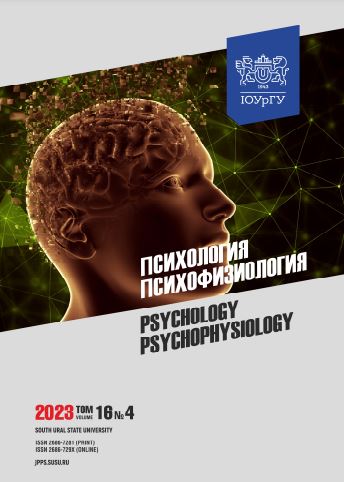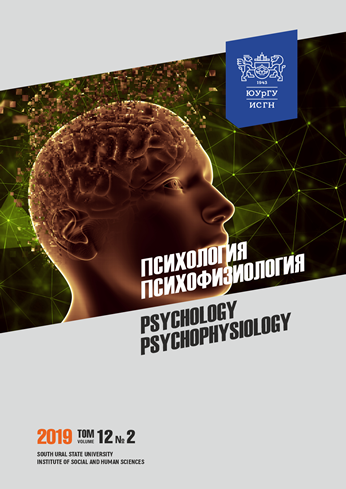Correlates of aggressive behavior in sports (a review)
Abstract
Introduction. The rising number and frequency of aggression incidents in or around the sports arena underscores the importance of understanding and addressing sports aggression, including its causes, effects, and strategies to overcome its negative consequences. Aims: to provide a systematic review of modern foreign literature exploring the psychological manifestations and effects of aggressive behavior in athletes.
Methods. The search term “aggression athletes” was utilized to retrieve data from the “PubMed,”
“ScienceDirect,” and “ScienceGate” databases. Subsequently, the research findings were analyzed, synthesized, and organized into distinct sections. Results. The findings from studies exploring the predictors and correlates of aggression and aggressiveness in athletes of different sports are organized and presented. This includes an examination of the determinants of personal qualities and characteristics, as well as the situational factors that may lead to or influence athletes' manifestations of aggression. Conclusion. A comprehensive grasp of the factors linked to aggression and its triggers has the potential to markedly enhance the quality of psychological assistance provided to athletes during their training.
Downloads
References
2. Khan A., Ullah H., Iftikhar S. Gender differences and aggression: a comparative study of young and adult athletes. Journal of Social Research Development. 2021;2(1):49–53. DOI: 10.53664/jsrd/02-01-2021-05-49-53
3. Güvendi B., Işım A.T. Moral disengagement and aggression in fight sport athletes. Journal of Education and Training Studies. 2019;7(7):118. DOI: 10.11114/jets.v7i7.4244
4. Maxwell J.P., Visek A.J. Unsanctioned aggression in rugby union: relationships among aggressiveness, anger, athletic identity, and professionalization. Aggressive Behavior. 2009;35(3):237–243. DOI: 10.1002/ab.20302
5. Xia X., Zhang J., Wang X., Wang X. The Approach behavior to angry words in athletes-a pilot study. Frontiers in Behavioral Neuroscience. 2019;13:117. DOI: 10.3389/fnbeh.2019.00117
6. Šniras Š. Expression of Aggression of Athletes and Non-Athletes. Sporto mokslas (Sport Science). 2016;4(86):20–27. DOI: 10.15823/sm.2016.38
7. Nouri S., Beer J. Relations of moderate physical exercise to scores on hostility, aggression, and aggression, and trait-anxiety. Perceptual and Motor Skills. 1989;68(3Pt2):1191–1194. DOI: 10.2466/pms.1989.68.3c.1191
8. Rui S., Cruz F.A. Unveiling anger and aggression in sports: The effects of type of sport, competitive category and success level. Revista de Psicología del Deporte. 2017;26:21–28.
9. Peña M.A.G., Escribano M.D., de Mesa C.G.G. Emotional intelligence and aggressive behavior in sport. Can sports modality and hours of training infer? Retos. 2018:176–180. DOI: 10.47197/retos.v0i35.66213
10. Bovolon L., Mallia L., De Maria A. et al. Modulatory role of sport factors on amateur and competitive athletes aggressive and antisocial behaviors. Heliyon. 2024;10(1):e23321
11. Schmidt J.D., Pierce A.F., Guskiewicz K.M. et al. Safe-play knowledge, aggression, and head-impact biomechanics in adolescent ice hockey players. Journal of Athletic Training. 2016;51(5):366–372. DOI: 10.4085/1062-6050-51.5.04
12. Marks M.E., Flood W.C., Kelley M.E. et al. Relationship between aggressiveness, self-confidence, and perceived coach support and head impact exposure in youth football. Sports (Basel). 2022;10(8):115. DOI: 10.3390/sports10080115
13. Limpo T., Tadrist S. Measuring sports perceived benefits and aggression-related risks: karate vs. football. Frontiers in Psychology. 2021;11:625219. DOI: 10.3389/fpsyg.2020.625219
14. Işık M., Kılıç İ., Aksoy K. Aggression levels of hearing impaired athletes: A comparison on individual and team sports. Journal of Human Sciences. 2017;14(4):3221. DOI: 10.14687/jhs.v14i4.4832
15. Lutkova N., Makarov Y. Psycho-physiological status of players during the attack under game conditions. Science and sport: current trends. 2020;8(2):86–92. DOI: 10.36028/2308-8826-2020-8-2-86-92
16. Barczak A., Guszkowska M., Adamczyk J.G. et al. Aggression in the Polish elite combat sports athletes. Studies in Sport Humanities. 2019;26:7–15. DOI: 10.5604/01.3001.0014.1247
17. Daniels K., Thornton E.W. An analysis of the relationship between hostility and training in the martial arts. Journal of Sports Sciences. 1990;8(2):95–101. DOI: 10.1080/02640419008732137
18. Stanković N., Todorović D., Milošević N. et al. Aggressiveness in judokas and team athletes: predictive value of personality traits, emotional intelligence and self-efficacy. Frontiers in Psychology. 2022;12:824123. DOI: 10.3389/fpsyg.2021.824123
19. Kostorz K., Sas-Nowosielski K. Aggression dimensions among athletes practising martial arts and combat sports. Frontiers in Psychology. 2021;12:696943. DOI: 10.3389/fpsyg.2021.696943
20. Wlazło A., Szuszkiewicz M., Wlazło E. Self-aggression in athletes practicing combat sports. Physical Education and Sport. 2007;51(1):67–71. DOI: 10.2478/v10030-007-0018-7
21. Sysoeva O.V., Maluchenko N.V., Timofeeva M.A. et al. Aggression and 5HTT polymorphism in females: study of synchronized swimming and control groups. International Journal of Psychophysiology. 2009;72(2):173–178. DOI: 10.1016/j.ijpsycho.2008.12.005
22. Gacar A. Examination on the aggression levels of Turkish national skiing athletes. Annals of applied sport science. 2015;3(3):1–8
23. Greitemeyer T. The dark side of sports: Personality, values, and athletic aggression. Acta Psychologica. 2022;223:103500. DOI: 10.1016/j.actpsy.2022.103500
24. Karimi J., Mohammadi M. The relationship between spiritual intelligence and aggression among elite wrestlers in Hamadan province of IRAN. Journal of Religion and Health. 2020;59(1):614–622. DOI: 10.1007/s10943-017-0525-7
25. Rinanda F.Z., Haryanta H. Hubungan antara kecerdasan emosi dengan agresivitas pada atlet futsal. Gadjah Mada Journal of Psychology. 2019;3(1):37. DOI: 10.22146/gamajop.42398
26. Bandura A. Self-efficacy: Toward a Unifying Theory of Behavioral Change. Psychological Review. 1977;84(2):191–215.
27. Chen X., Zhang G., Yin X. et al. The relationship between self-efficacy and aggressive behavior in boxers: the mediating role of self-control. Frontiers in Psychology. 2019;10:212.
DOI: 10.3389/fpsyg.2019.00212
28. Zhang J., Xie C. The correlation between cognitive control and relational aggression of Sportsmen adults: How do emerging learning technologies matter? Research Square. 2023. DOI: 10.21203/rs.3.rs-3343519/v1.
29. Xia X., Zhang G., Wang X. Anger weakens behavioral inhibition selectively in contact athletes. Frontiers in human neuroscience. 2018;12. DOI: 10.3389/fnhum.2018.00463
30. Mahmoudi E., Nakhostin-Ansari A., Ranjbar M., Memari A.H. Are all types of empathy associated with lower aggression in athletes? A cross-sectional study on Iranian athletes. BMC Psychology. 2022;10(1):276. DOI: 10.1186/s40359-022-00985-4
31. Çirmi E., Turan S. Investigation of empathy skills and moral decision-making attitudes in athlete students in terms of some variables. Journal of Educational Issues. 2021;7(2):275. DOI: 10.5296/jei.v7i2.19072
32. Pourabdol S., Roshan R., Yaghubi H. et al. Relationship between intensity of anger and its expression in competitive athletes: mediating role of emotion dysregulation. Avicenna Journal of Neuropsychophysiology. 2020;7(3):165–171.
33. Pacesova P., Smela P. Aggression and anxiety trait level of young male contact and noncontact athletes. Acta Gymnica. 2020;50(1):9–15. DOI: 10.5507/ag.2020.001
34. Tiric-Campara M., Tupkovic E., Mazalovic E. et al. Correlation of aggressiveness and anxiety in fighting sports. Medical Archives. 2012;66(2):116–121. DOI: 10.5455/medarh.2012.66.116-121
35. Kim H.H., ho Choi Y., Oh S.Y. The relationship among burnout syndrome, aggression, and anti-social behavior of high school athletes. Journal of Korean Society for the Study of Physical Education. 2021;25(4):295–307. DOI: 10.15831/jksspe.2021.25.4.295
36. Behjame F., Zandi H.G., Khabiri M. The role of cognitive emotion regulation strategies on predicting aggression and competitive anger among athletic students. International journal of motor control and learning. 2021;3(4):19–26
37. Bartels M., Hudziak J.J., van den Oord E.J. et al. Co-occurrence of aggressive behavior and rule-breaking behavior at age 12: multi-rater analyses. Behavior Genetics. 2003;33(5):607–621. DOI: 10.1023/a:1025787019702
38. Pavlov K.A., Chistiakov D.A., Chekhonin V.P. Genetic determinants of aggression and impulsivity in humans. Journal of Applied Genetics. 2012;53(1):61–82. DOI: 10.1007/s13353-011-0069-6
39. Giammanco M., Tabacchi G., Giammanco S. et al. Testosterone and aggressiveness. Medical Science Monitor. 2005;11(4):RA136–RA145
40. Nishizawa, S., Benkelfat, C., Young, S.N. et al. Differences between males and females in rates of serotonin synthesis in human brain. Proceedings of the national academy of sciences of the United States of America. 1997;94(10):5308–5313
41. Harro J., Laas K., Eensoo D. et al. Orexin/hypocretin receptor gene (HCRTR1) variation is associated with aggressive behaviour. Neuropharmacology. 2019;156:107527. DOI: 10.1016/j.neuropharm.2019.02.009
42. Ring C., Kavussanu M., Willoughby A. Pain thresholds, pain-induced frontal alpha activity and pain-related evoked potentials are associated with antisocial behavior and aggressiveness in athletes. Psychology of Sport and Exercise. 2016;22:303–311. DOI: 10.1016/j.psychsport.2015.09.003
43. Gang L.I. Relationship of executive function and antisocial behavior and aggression in athletes. Journal of Shandong Sport University. 2016(05):79–82. DOI: 10.14104/j.cnki.1006-2076.2016.05.014
44. Yurgelun-Todd D., McGlade E., Bueler E. et al. The relationship between self-ratings of aggression and insular cortical thickness in collegiate football athletes. Medicine and Science in Sports and Exercise. 2015;47(5S):504. DOI: 10.1249/01.mss.0000477818.41321.ff
45. Dane S., Sekertekin M.A. Differences in handedness and scores of aggressiveness and interpersonal relations of soccer players. Perceptual and Motor Skills. 2005;100(3Pt1):743–746. DOI: 10.2466/pms.100.3.743-746
46. Chow G.M., Murray K.E., Feltz D.L. Individual, team, and coach predictors of players likelihood to aggress in youth soccer. Journal of Sport and Exercise Psychology. 2009;31(4):425–243. DOI: 10.1123/jsep.31.4.425
47. Mazer J.P., Barnes K., Grevious A., Boger C. Coach verbal aggression: a case study examining effects on athlete motivation and perceptions of coach credibility. International Journal of Sport Communication. 2013;6(2):203–213. DOI: 10.1123/ijsc.6.2.203
48. Michel-Kröhler A., Kaurin A., Heil L.F., Berti S. Self-distancing as a strategy to regulate affect and aggressive behavior in athletes: an experimental approach to explore emotion regulation in the laboratory. Frontiers in Psychology. 2020;11:572030. DOI: 10.3389/fpsyg.2020.572030
49. Kerr J.H., Grange P. Athlete-to-athlete verbal aggression: a case study of interpersonal communication among elite Australian footballers. International Journal of Sport Communication. 2009;2(3):360–372. DOI: 10.1123/ijsc.2.3.360
50. Rychkova L., Koneva O., Morozova S. et al. Innovative approaches to reducing conflict and aggression in womens basketball team play. Human. Sport Medicine. 2020;19(4):92–102. DOI: 10.14529/hsm190411
51. Vveinhardt J., Fominiene V.B., Andriukaitiene R. Encounter with bullying in sport and its consequences for youth: amateur athletes approach. International Journal of Environmental Research and Public Health. 2019;16(23):E4685. DOI: 10.3390/ijerph16234685
52. Fruchart E., Rulence-Paques P. Mapping Positions on Forgiving an Aggressor in Sport. Frontiers in Psychology. 2021;12:561031. DOI: 10.3389/fpsyg.2021.561031
53. Milovanović I., Gentile A., Gutović T. et al. Prosocial and Aggressive Behavior Occurrence in Young Athletes: Field Research Results in Six European Countries. Sustainability. 2020;12(12):5085. DOI: 10.3390/su12125085
54. Moore C. Moral disengagement. Current Opinion in Psychology. 2015;6:199–204. DOI: 10.1016/j.copsyc.2015.07.018
55. Javed S., Naseer A., Asghar A. Impact of social support and aggression on sport achievements of university student athletes. Global Physical Education and Sports Sciences Review. 2019;II(I):10–19. DOI: 10.31703/gpessr.2019(ii-i).02
56. Naicker N., de Jager P., Naidoo S., Mathee A. Is there a relationship between lead exposure and aggressive behavior in shooters? International Journal of Environmental Research and Public Health. 2018;15(7):1427. DOI: 10.3390/ijerph15071427
57. Erle T.M., Barth N., Kälke F. et al. Are target-shooters more aggressive than the general population? Aggressive Behavior. 2017;43(1):3–13. DOI: 10.1002/ab.21657
58. Kim S.E., Kim Y., Hashizume M. et al. Positive Association of Aggression with Ambient Temperature. The Yale Journal of Biology and Medicine. 2023;96(2):189–196. DOI: 10.59249/rxzx5728
59. Gülle M., Bolat Y. The effect of birth month and seasons on athlete aggression. Journal of Education and Learning. 2021;15(4):592–600. DOI: 10.11591/edulearn.v15i4.19810
60. Geng L., Hong X., Zhou Y. Exploring the implicit link between red and aggressiveness as well as blue and agreeableness. Frontiers in Psychology. 2021;11:570534. DOI: 10.3389/fpsyg.2020.570534
61. Krenn B. The effect of uniform color on judging athletes aggressiveness, fairness, and chance of winning. Journal of Sport and Exercise Psychology. 2015;37(2):207–212. DOI: 10.1123/jsep.2014-0274
References on translit
-Copyright (c) 2023 Psychology. Psychophysiology

This work is licensed under a Creative Commons Attribution-NonCommercial-NoDerivatives 4.0 International License.



